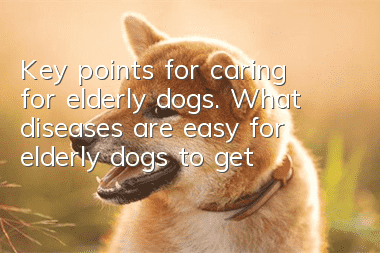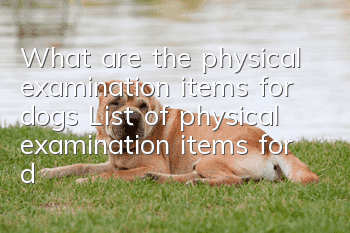Key points for caring for elderly dogs. What diseases are easy for elderly dogs to get?

Physical characteristics of dogs entering old age:
1. Decline in metabolism, energy, and organ function decline.
2. Reduced food intake, reduced muscle tone, accelerated calcium loss, and joint stiffness.
3. The coat of older dogs is prone to becoming tangled, dry and scaly due to reduced sebaceous gland secretion.
4. Hearing and vision will gradually be lost as dogs age.
5. Older dogs often have tooth and gum diseases, which can affect eating.
Five fatal factors for elderly dogs
Cancer 47%
Heart disease 12%
Kidney disease 7%
Liver disease 4%
Epilepsy 4%
So what kind of nutrition do elderly dogs and cats need?
Older dogs and cats generally need low-calorie food to help prevent obesity, a common problem that older dogs encounter. Because nutritious liquid food requires higher quality protein, this is especially important for thin and sick dogs and cats!
High fiber helps improve gastrointestinal health. Offer healthy, low-fat (to prevent pancreatitis), low-sodium snacks. Water needs also increase with age, because the body needs water to balance, and more of the body's functions begin to decline with age, so remember to ensure that older dogs have enough water.
Old dogs need high-quality protein
The "Report on Nutritional Requirements of Dogs and Cats" published in 2006 pointed out that old dogs need to consume higher protein (about 50% higher than the average adult dog) ) to maintain optimal immune response, heal wounds, and ensure good health in old age.
Note: A 1-year-old dog needs 2.5g of protein per kilogram of body weight per day, and a 12- to 13-year-old dog needs 3.75g of protein per kilogram of body weight per day.
Both AAFCO (American Association of Feed Control Officials) and the American Nutrient Regulatory Commission (National Research Council) recognize rules for this nutrient requirement
Elderly pets should not reduce their protein intake, but should consume high-quality protein.
If the animal is in a state of caloric deficit due to emaciation, excess protein will be used as a source of energy.
On the contrary, if the animal is under caloric deficiency or caloric excess, excess protein will be stored as fat, and nitrogenous materials will be excreted in the urine. Unlike fats and carbohydrates, amino acids cannot be stored in the body for future use.
Recent research has shown that older dogs can indeed help improve age-related loss of muscle mass from slightly higher quality protein and increased protein in their diet.
Senior Dog and Cat CampSuggestions for nutritional adjustment:
1. Do not feed food that is too salty to avoid increasing the burden on the heart.
2. Reduce fat intake. (Note: Fat is necessary for the body, it is not eliminated but reduced)
3. Reduce caloric (energy) sugar intake to prevent weight gain.
4. Adjust protein intake and choose high-quality protein, especially for dogs and cats that are too thin, sick, or undergoing surgery.
5. Pay attention to calcium loss and supplement calcium appropriately.
6. Choose food specially designed for aging pets with balanced nutrition.
AAFCO’s specific requirements for food for senior dogs and cats are as follows:
Contains complex carbohydrates with a lower glycemic index, such as whole grains and vegetables
Contains an above-average proportion of easily digestible proteins such as lean meat, organ meats, and eggs
Contains a moderate amount of healthy fats (10 -15%), including essential fatty acids
Contains added minerals and vitamins including zinc, copper, selenium and vitamins A, D, E and K+ B1,2,3,5,6-12. Folic acid and biotin.
- What's going on with the dog's butt mopping the floor? Do you understand the reason?
- Can dogs eat bananas? What fruits can dogs eat?
- How to treat depression in dogs? Your company is more important than depression medicine
- Why can’t puppies be bathed? Under what circumstances can dogs not be bathed?
- What are the benefits of eating bones for dogs? What bones should dogs not eat?
- If you don’t have symptoms of Alzheimer’s disease in dogs, take precautions as soon as possible
- How to tell whether a Schnauzer is pure or not? Teach you how to identify a purebred Schnauzer
- How to tell if your dog has parasites? You need to master these tips
- Teddy likes his owner's behavior. You will know if Teddy likes it or not!
- Symptoms of trace element deficiency in dogs. Have you seen the trace element deficiency in dogs?



